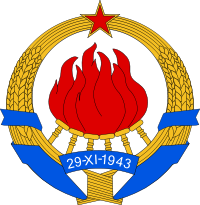- Emblem of the Socialist Federal Republic of Yugoslavia
-
Emblem of Yugoslavia 
Versions 
Emblem of FPR Yugoslavia (1943-1963). This version featured five torches that represented the brotherhood and unity of the five Yugoslav nations.Details Use As official emblem of Yugoslavia The emblem of the Socialist Federal Republic of Yugoslavia featured six torches, surrounded by wheat with a red star at its top, and burning together in one flame; this represented the brotherhood and unity of the six federal republics forming Yugoslavia: SR Bosnia and Herzegovina, SR Croatia, SR Macedonia, SR Montenegro, SR Serbia and SR Slovenia. The date imprinted is 29 November 1943 - on this date the Anti-Fascist Council of National Liberation of Yugoslavia (AVNOJ) met in Jajce on its second meeting and formed the basis for post-war organisation of the country, establishing a federal republic (this date was celebrated as Republic Day after World War II).
Contents
History
During World War II (1943–1945), the Yugoslav state was named Democratic Federal Yugoslavia (DFY), in 1945 it was renamed Federal People's Republic of Yugoslavia (FPR Yugoslavia), and again in 1963 into Socialist Federal Republic of Yugoslavia (SFR Yugoslavia). The emblem of socialist Yugoslavia was designed in 1943 and remained in use up to 1963, when the country underwent reforms and was renamed for the final time. It featured five torches surrounded by wheat and burning together in one flame; this represented the brotherhood and unity of the five nations of SFR Yugoslavia: Croats, Serbs, Montenegrins, Macedonians, and Slovenes. The ethnic Muslims weren't represented as a constituent nation.
As part of the 1963 reforms, the name of the country was changed into Socialist Federal Republic of Yugoslavia and its emblem was redesigned to represent six Yugoslav federal republics (instead of the five nations). The new emblem was the final version with six torches, and was in official use up to the country's dissolution in 1992. The date of the insignia remained the same, 29 November 1943, the date the Anti-Fascist Council of National Liberation of Yugoslavia (AVNOJ) met in Jajce on its second meeting.
Republic emblems
The emblems of the Yugoslav socialist republics were defined by each of its six constituent republics. Emblems appeared as a symbol of statehood on the documents of republican level, for example on the signs of the republican institutions, on watermarks of school diplomas, etc. The emblems included old historical symbols where they could to demonstrate historical compatibility with the new socialist political system – see Croatian and Serbian traditional emblem in the middle of their coats of arms; also Slovenian Mount Triglav was recognized as a symbol of Slovenian Liberation Front during the National Liberation War during World War II. Where the old symbols were deemed inappropriate (the traditional cross on the Serbian coat of arms, ethnic or religious coat of arms for Bosnia and Herzegovina, the former traditionally monarchist symbolism for Montenegro or the historical lion for Macedonia), prominent features or unofficial national symbols were added, e.g. mount Lovćen for Montenegro, chimneys for Bosnia and Herzegovina.
In a similar fashion to the federal Yugoslav emblem all republican emblems featured a red star and wheat or other important plants of the region. The individual emblems of the six Yugoslav socialist republics were as follows:
Republic Emblem Author Republic-specific features Present-day coat of arms SR Bosnia and Herzegovina 
Unknown Plants Conifer twig (left), Deciduous twig (right), two sheaves of wheat (lower middle portion) 
Coat of arms of Bosnia and HerzegovinaLandscapes,
geographic featuresSilhouette of Jajce Industry two factory chimneys Ornaments red track SR Croatia 
Antun Augustinčić
and Vanja Radauš[1]Plants Wheat 
Coat of arms of CroatiaLandscapes,
geographic featuresAdriatic Sea, Rising sun Industry Iron anvil Ornaments Chequy SR Macedonia 
Vasilije Popović–Cico[2] Plants Garland of wheat, tobacco leaves and poppy buds 
Coat of arms of MacedoniaLandscapes,
geographic featuresRiver Vardar, Mount Korab, sunrise, sky Industry – Ornaments ribbon with traditional Macedonian embroidery SR Montenegro 
Milan Božović[3]
and Milo Milunović[3]Plants laurel wreath 
Coat of arms of MontenegroLandscapes,
geographic featuresMount Lovćen,[4] Adriatic Sea Industry – Ornaments Montenegrin[4] tricolour of Pan-Slavic colors SR Serbia 
Đorđe Andrejević Kun Plant sheaf of wheat (left), sheaf of oak leaves with acorns (right) 
Coat of arms of SerbiaLandscapes,
geographic featuressunrise, sky Industry cog-wheel Ornaments red track (with inscriptions), Serbian traditional symbol SR Slovenia 
Branko Simčič Plants wheat, leaves of linden 
Coat of arms of SloveniaLandscapes,
geographic featuresTriglav, sea[5] Industry – Ornaments red ribbon See also
- Flag of Yugoslavia
- List of Yugoslav flags
- Coat of arms of Bosnia and Herzegovina
- Coat of arms of Croatia
- Coat of arms of Macedonia
- Coat of arms of Montenegro
- Coat of arms of Serbia
- Coat of arms of Serbia and Montenegro
- Coat of arms of Slovenia
References
- ^ Stuparić, Darko. Diplomati izvan protokola : ambasadori Titove Jugoslavije, Centar za kulturnu djelatnost Saveza socijalističke omladine Zagreba, Zagreb, 1978., p. 75.
- ^ Jonovski, Jovan. Coats of arms of Macedonia, Macedonian Herald, Electronic Version, heraldika.org.mk, No. 3, March 2009, p. 9.
- ^ a b Markuš, Jovan B. Grbovi, zastave i himne u istoriji Crne Gore (Библиотека Свети Петар Цетињски), "Svetigora" (Izdavačko-informativna ustanova Mitropolije Crnogorsko-primorske), Cetinje, 2007., p. 47-48., ISBN 978-86-7660-054-0
- ^ a b Excerpt from the Constitution of the Socialist Republic of Montenegro (1963) in: Guć, Nedeljko. (ed.) Društveno-političko uređenje, pravosuđe, uprava, (Zbirke propisa I-IV), knj. 1, Prosveta, Beograd, 1967, p. 303.
Члан 7.
Грб Социјалистичке Републике Црне Горе представља поље окружено ловоровим вијенцем који је доље повезан црногорском заставом. Између врхова ловоровог вијенца је петокрака црвена звијезда, а у средини поља представљен је Ловћен. Позади Ловћена с неколико вијуга представљено је Јадранско море.—Guć, 1967, 303 - ^ 8. člen Ustave Socialistične republike Slovenije (1974)
External links
Categories:- National symbols of Yugoslavia
- Coats of arms of former countries
- Second Yugoslavia
- Bosnia and Herzegovina coats of arms
- Croatian coats of arms
- Montenegrin coats of arms
- Serbian historical coats of arms
- National emblems
Wikimedia Foundation. 2010.
